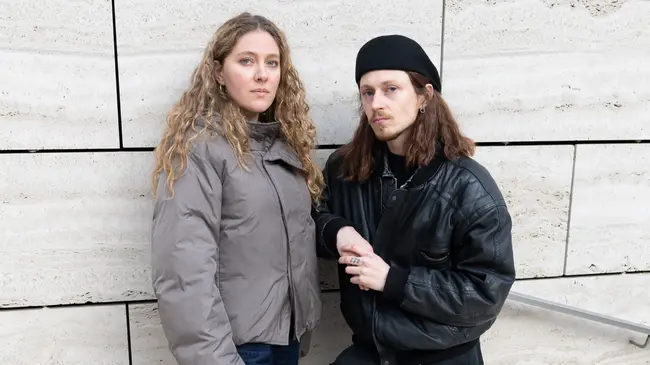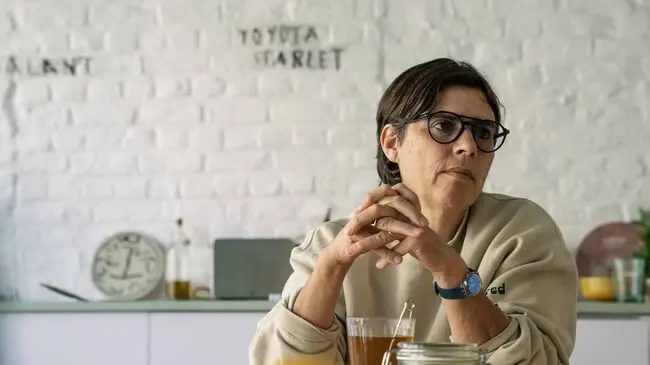Dressing and undressing allows us to jump across identities

In life and in her photography, New Master Hanna Pallot finds ways to celebrate the unboundedness of bodies. As we visited the Masculinities exhibition at the Fashion and Lace Museum and moved in between silhouettes created by Dries Van Noten, Walter Van Beirendonck, Raf Simons and many more, the Brussels-based photographer talked us through how she uses nudity to uncover vulnerability.
What did you think of the Masculinities exhibition?
Two themes in the exhibition particularly stuck out to me: vulnerability and nudity. These elements are typically linked to femininity, so it is great to see them extended to the masculine sphere. The exhibition is built to use fashion to progressively deconstruct questions about what a man is and what a man is supposed to look like. As I moved through the exhibition, I also felt the boundaries between masculinity and femininity becoming very thin and blurred, which I liked a lot.
Through nudity, vulnerability features heavily in the work. Why does (un)dressing speak to you?
When I became interested in feminism, I realized that photographing women's bodies was my way to overcome the stereotypes of women's bodies that are typically promoted. In a sense, it is how I celebrate the diversity of ways one can be a woman.
It’s funny because the exhibition is about fashion and one of the main themes in my work is nudity. I think they go together. There is something very beautiful and intimate about someone showing a vulnerable side of themselves when they are naked. These days, more than ever, we can sculpt our own bodies, which is where dressing and undressing come in. Dressing and undressing allow us to jump across identities and explore how we can express ourselves.
Dressing and undressing allow us to jump across identities and explore how we can express ourselves
How do you look at fashion as a way to sculpt and express identities?
I have always been very interested in the question of identity. I am not comfortable defining myself, so capturing other people’s identities in my photography allows me to reflect on that. I have been questioning the notion of femininity and realized that the boundaries between masculinity and femininity are very blurred. Besides this big question of identity, I am questioning a lot of related things. What does it mean to become a woman? What is femininity? What is masculinity? How do we give new definitions of looking at these terms beyond stereotyped definitions?
In the exhibition, some designers found ways to use fashion to affirm and express beyond these binaries. To me, the power of fashion lies in these examples, which contest heteronormative notions and move away from binaries.
Some designers found ways to use fashion to affirm and express beyond [these] binaries in the exhibition. To me, the power of fashion lies in these examples, which contest heteronormative notions and move away from binaries
Dance is also important to you and your work. What role does movement play in your photography?
The Israeli choreographer Ohad Naharin said that if everyone would dance a little bit every day, the world would be better, and I couldn't agree more. Even though I have been dancing since I was a kid, I realized quite late how important dance was to my work and my personal development. I started incorporating dance in my photography to work through this frustration. I thought if I am not a dancer myself, how can I build choreographies with others?
In my images, I try to build choreographies that erase as many boundaries between bodies as possible and show them as a connected whole, until there appears to be a wall of bodies.
Is the body a topic that you would like to continue to explore in your work?
I believe the body will always be central to my work. Right now, I am doing a photographic series with a variety of people. I typically work with dancers, which is very interesting. That said, I also enjoy working with people who are less aware of what their body is capable of doing. I am hoping that this experience can give the participants the possibility to explore the limits of their own bodies.
As for the near future, I just finished a project called A·ux Nu·es with Gabrielle Mogenet that links writing, music, dance, and video. For the last three years, I have been working around the experience of being a woman in a bathroom. In January, I surveyed 150 women about what they do in the bathroom and how they see themselves in that space. To me, the bathroom is an environment where different types of femininity and masculinity can meet each other. That's what our new project explores through text, performance, dance, and video.
What’s the most interesting thing you’ve learned - and that’s surprised you most - about the body?
Every body has endless possibilities to change, more than you can imagine.
Different Class works with the interest of their community at heart.
Our work’s purpose is to foster a solid network for independent artists, those who love them, and those who want to support them. Become a member to contribute to the local Belgian art scene.





